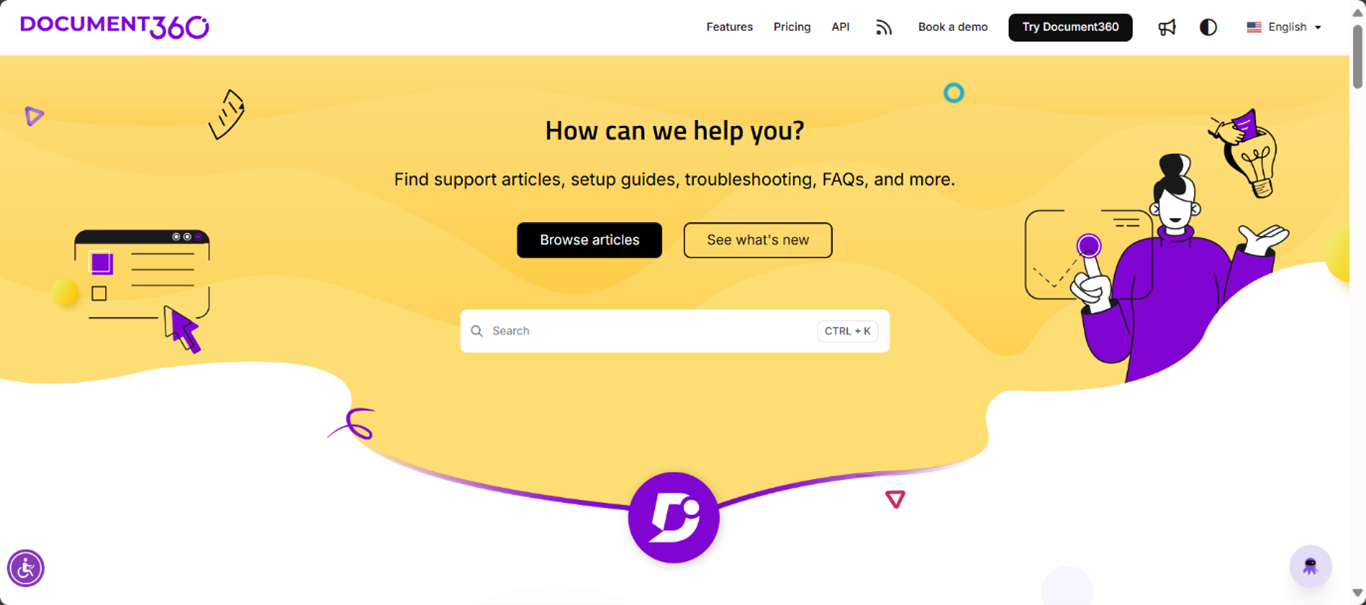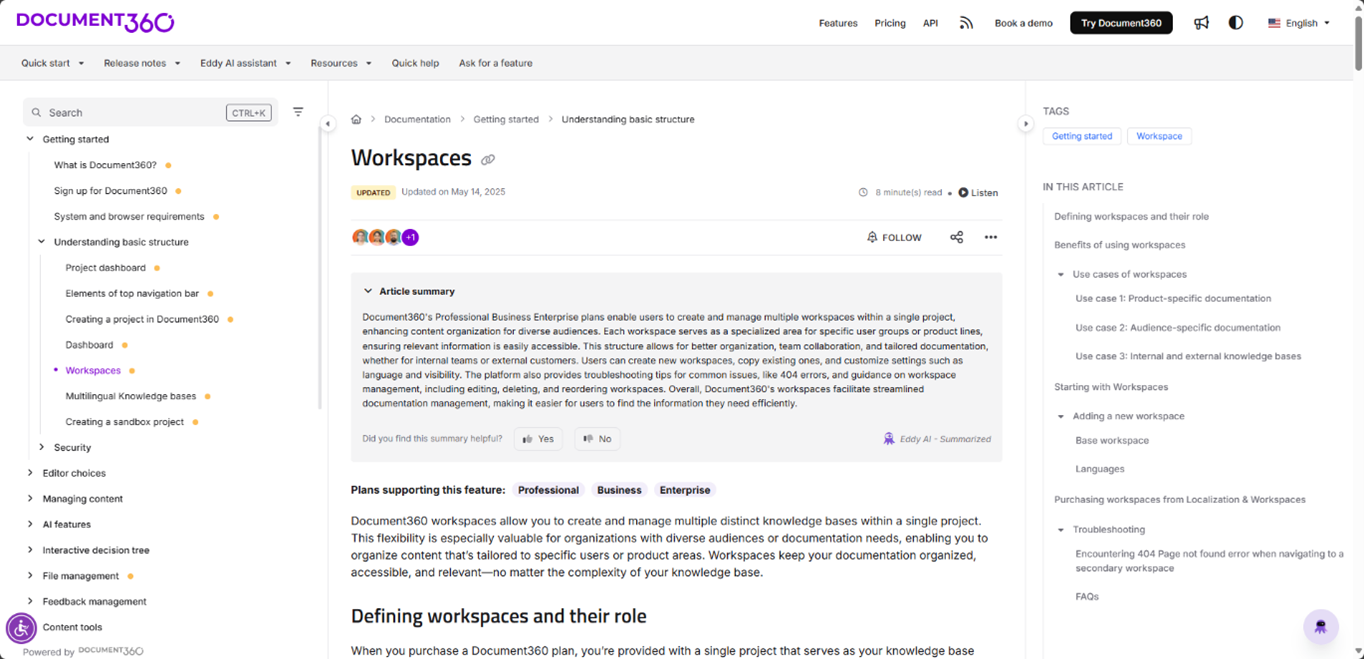Just like how a proper foundation is essential for any building, a knowledge base is essential for your product to serve your customers and internal teams. Whether you’re building an internal knowledge base or a self-service customer support center, it must provide valuable content to your readers.
Your knowledge base is an essential tool since it allows you to help more customers at the same time, without increasing costs or lowering quality.
Every article should give readers what they need, want, and crave! Anything less, and all the resources you’ve put into creating your knowledge base articles will go to waste.
It is of utmost importance to provide your readers with accurate and valuable information. After all, your knowledge base is the most legitimate source of information about your software and its features.
You need to provide trustworthy, well-organized content in easy-to-read chunks.
Here’s a simple guide to creating a knowledge base that sets the standard for information in your industry.
The Anatomy Of A Usable Knowledge Base
Your purpose when creating a knowledge base is to satisfy your audience–which means you have to give them what they want when they want it.
31 percent of customers are looking for instant online help, while 40 percent of them expect to receive assistance in less than five minutes.
People expect to find everything they need on your website, with minimum effort and within minutes.
To meet those expectations, your knowledge base should be:
- Well-organized – The structure should follow a logical flow and make sense as a whole.
- Intuitive and easy to navigate – Even first-time visitors should be able to find the articles they need fast.
- Highly informative – Each article should possess a goal and provide clear, relevant information that assists readers in understanding the feature.
Think About Your Users’ Goals
When it comes to your users’ goals, you need to start with the question, “What do my readers need to achieve their goal?”. Then, focus on providing your audience with the right tools to solve their problems themselves.
You must provide all the information needed. At the same time, the articles should stay relevant and be easy to scan through and read. If a customer has to go through 3,000 words to learn how to change settings for an account, you’re providing a poor customer experience.
The way you present the information is more important than the information itself.
Even the best articles will get zero engagement if people need half an hour to find an answer in a long list of items.
Information architecture (IA) is the way of structuring and organizing your content to help your audience know where they are as users and how to find what they’re looking for.
How can you practice information architecture to increase the usability of your knowledge base?
Here are a few tips:
- Divide your content into categories and organize articles by topics, themes, and sub-themes. Each piece should treat one question (or problem) only.
- Make navigation easy by linking related articles to guide your readers on a logical path.
- Design a user-friendly menu that allows readers to know where they are and gives them an easy way to get to another category.
- Implement a killer search engine to help readers find what they need.
- Use visual design and colors to help people differentiate the content.
- Break the information into small chunks to allow your readers to assimilate what they read.
- Guide users with solid UX techniques to lower the time they spend looking for information
Keep your audience in mind. For a public knowledge base, it would be the general public; for the internal knowledge base, it would be your employees and for self-service support, it would be your customers.
Document360 as an Example

Document360 provides a clean and user-friendly example of how to structure a knowledge base effectively. When you land on the documentation site, the first thing you notice is a well-organized interface with a prominent search bar. It encourages users to find information quickly without scrolling or navigating to multiple articles.
The top headers include important resources such as Features, Pricing, API documentation, and RSS feed. You can also book a demo, sign up to try Document360, or explore the latest article updates through the What’s New section. There is also a theme switcher for light and dark modes, and you can also explore your documentation in multiple languages.
The homepage features a welcoming message like “How can we help you?” Below this, a brief description directs users to helpful resources such as the setup guide, FAQs, and support articles. There are also two call-to-action buttons — Browse articles and See what’s new — allowing users to explore the knowledge base and quickly view the latest updates.
As you scroll down, you will find three highlighted content cards for Getting started, Pricing, and Release notes, giving new users a clear starting point. Further down, the Browse by category section showcases the latest documentation categories. You will also come across testimonials from real users sharing their positive experiences with Document360.
Just below that, there is a section displaying recently updated articles, organized under themes such as Authoring & Publishing, Key Features, and Security. Then, you will find a dedicated section for How-to videos that provide visual guidance to users who prefer to learn.
At the bottom of the page, a Contact Us section gives users several ways to reach out—whether by submitting a support ticket, sharing product feedback, or chatting live with the support team. The page ends with a simple, well-structured footer.
When you click on Browse articles, you are taken to the documentation page. On the left navigation bar, you can view the available categories and articles. Each category expands into subcategories with specific articles, making it easier for users to find the information they need. Additionally, breadcrumbs help users see where they are within the knowledge structure.

Within each article, there is a table of contents on the right, allowing users to navigate long articles quickly. Using hyperlinks, you can cross-reference relevant pieces of information across the documentation or external sources. The structure is not only user-friendly but also scalable for growing businesses, which often require updates or additional content.
Why Minimal Design Matters in a Knowledge Base?
The Document360 knowledge base also embraces a minimum design philosophy, which focuses on clarity over looks. The typography, color and layout are consistent with the overall brand identity but never distracting. There are no unnecessary popups or clutter, just a clean place where users focus on receiving the answers they need.
Each article is structured for readability. Paragraphs are small, white spaces are used generously, and important terms are highlighted for emphasis. Wherever necessary, tables, bullet points, and inline links break down complex topics into digestible bits.
Users today expect instant results. Document360 combats this by chunking content into logical segments and providing navigation tools (like tables of contents and breadcrumb trails) that always let you know where you are on your journey.
From the first click to the final answer, the knowledge base design of Document360 keeps users at the center. It is clean, comfortable, and flexible.
Long pages are a nightmare to read without proper organization. Internet users today lose their concentration after eight seconds. So break the information into chunks that users can read without being confused!
Structure your articles for the average user. Keep paragraphs short. Use boldface for vital information to emphasize its importance.
Knowledge Base Design Best Practices
- Optimize for all devices. Two-thirds of global traffic comes from mobile devices. So, look for knowledge-based solutions that allow you to provide excellent customer support on smartphones, tablets, and desktops.
- Make your search bar visible. It should catch your visitors’ attention from the first moment they land on your page. (Don’t hide it in the corner!)
- Add quick links to hot topics and frequently asked questions to improve navigation. Also include links to related articles for people who need to learn more about a specific topic.
- Use colors to differentiate the main categories and topics. Consider calming and relaxing colors, like blue, green, or yellow. Excessively bright colors aren’t going to calm down an already stressed user!
- Introduce a Table of Contents for long articles. This way, users can jump to the section they’re interested in and save time.
- Use white space to make the content easier to follow.
- Insert visuals to break up the long paragraphs – screenshots, videos, graphics, or any other tool that can help readers better understand what they’ve read. Images add interest and clarity and help the eye and the brain to take a rest from the text.
- Highlight the section where users can get more help. Users need to see that they can contact you when self-service alone fails to give them accurate answers.
- Consider adding a chatbot widget to your knowledge base. Chatbots help users quickly without leaving the page.
- Prioritize accessibility by including tools that let users customize their reading experience, such as increasing contrast, adjusting text size and spacing, pausing animations, and changing color saturation. These features help make your content usable for everyone, including those with visual impairments or reading difficulties.
Writing Optimised Knowledge Base Articles
A practical knowledge base provides value. You need to create lasting, strong content to satisfy your users, whether you address your employees in an internal knowledge base or your customers.
In our guide “How to Write an Incredible Knowledge Base Article”, we explain how to craft professional but friendly content for all your users, based on thorough research about your public and their goals.
Keep this question in mind when writing: “How will my content positively affect my audience?”
Every article you publish in your knowledge base should give relevant information only. Cut all the fluff. If a paragraph doesn’t influence or change the user experience, remove it.
Back up your articles with facts that can be trusted, and update the information regularly. Users don’t need to read about an old version of your software if they’re already working with a more recent one.
Clear Titles Improve Navigation
Your titles and headlines must speak for themselves.
SEO is important for a knowledge base, but here, even more than on your business blog, you’re not writing for search engines and SERPs.
Write for humans. In some cases, angry, frustrated users need to dig through your website to find answers. They don’t want to call for help. So make their experience on your site as positive as possible.
You don’t need to hook them or draw attention. Your mission is to improve usability and navigation. When users click a title or headline, they should get to the article or paragraph they expect based on the information in that title.
Excellent headlines allow users to scan the document and read the parts they need without missing any vital information.
Keep things clear and use simple wording to express what the article is about. Add keywords in the titles and headlines to make the information easy to find with a simple search.
Use the previous questions people have asked in your Search bar to write better titles and headlines. This way, you can write in the same words that people use to search for answers in your internal knowledge base. For example, if many users search for ‘reset password,’ a title like ‘How to Reset Your Password’ is clearer and more useful than ‘Account Recovery Guide.’
Organize Your Ideas
Besides breaking the text into short paragraphs, you need to deliver the information in the right order for your readers to understand it.
Article templates can help you organize your ideas, but they alone can’t do the job for you.
Different types of articles require different writing techniques–it depends on the purpose of each piece you publish in your knowledge base tool.
When you want to explain a new product:
- Start with basic information and build up to more complicated instructions towards the end.
- Include video tutorials that show users how to install, set up, and use the software.
- Under the video, include a script where users who don’t have the time to watch can find the information they need.
When you write a how-to guide:
- Use chronological order to explain each step of the process
- For every new action, give clear instructions. Don’t make assumptions. Your users don’t know the product as well as you do. What seems like an obvious intermediate step for you may be unknown to a beginner.
- Include screenshots to explain menus, categories, and buttons that users should click to get to the right result.
When you give short answers to frequently asked questions:
- Skip the intro to keep visitors focused on their task.
- Give clear instructions, with links to the pages they need to access to solve their issue.
- Don’t use video to solve problems. Users need quick answers. If they can get them with a quick scan of a 2-minute text, they won’t sit and watch a 3-minute video.
Choose the Right Topics
Your knowledge base should include benefit-focused content only. Simple as that.
Instead of writing a hundred articles that you think might help, focus on your audience’s needs.
Research before you start writing:
- What do people look for online related to your industry?
- What do your competitors write in their knowledge bases?
- What problems that your current customers have?
- Which issues show up the most often in tickets from customer support?
- What do your employees need to increase productivity?
- How can you teach your employees new skills?
- How can you educate your clients to improve the customer experience?
Trends in the industry and your customers are also excellent sources to get topic ideas that could make your knowledge base more successful.
Solve problems and prevent further issues. This is what your customers want and deserve.
Choosing the Right Knowledge Base Software
The best thing about a knowledge base is that it is simple to put together once you have the right tools.
If you use WordPress, it’s easy to implement some free knowledge base solutions as plugins. When using a WordPress site as your knowledge base, there are some benefits of using a free tool, as well as limitations that come with it.
If your business is growing and you want to improve customer support, you need scalability and flexibility. For these features, you need a company knowledge base software that allows you to customize your knowledge base to meet your expectations.
When choosing the knowledge base solution, you should consider these essential elements:
- Excellent readability – users should be able to focus on your content only.
- Killer search function – it’s vital for quick and effortless navigation.
- Mobile friendly – with most users accessing information from their smartphones, you need to make your knowledge base available from any device.
- Cost-effective – you should calculate costs to try to get the best value for your money.
- Analytics – this feature helps you gather valuable data about your users and their habits. This way, you can improve your service based on your public’s preferences.
- Feedback collection – your customers should be able to evaluate your content.
- Integration – the perfect knowledge base software should be easy to integrate with all the other tools you use to grow your business (Google Ads, Intercom, Segment, Olark).
- Quick setup – the less time you need to install and update the software, the better. This way, you can focus on creative tasks rather than technical details.
- Excellent customer support – just as you’re looking to provide your customers with the best services, you should search for a partner who can hold your hand when you’re in trouble!
Final Thoughts on Knowledge Base Organisation and Structuring
Knowledge-based organization and structuring take time and effort. You need to put your ideas in order and find a reliable partner to help you with the technical details.
The way you deliver the information is what makes the difference between mediocre and excellent service. From the content you create to the way you break it into categories, everything should be customer-focused.
You need to have high usability, easy navigation, user-friendly features, and an optimized design to satisfy your users and increase efficiency.
Follow this beginner’s guide to knowledge base organization and structuring, and you’ll be able to deliver to customers what they want.
Are you ready to start organizing and structuring your company knowledge base? At Document360, we’ve got the tools and expertise to help you on your way!





 –
– 

